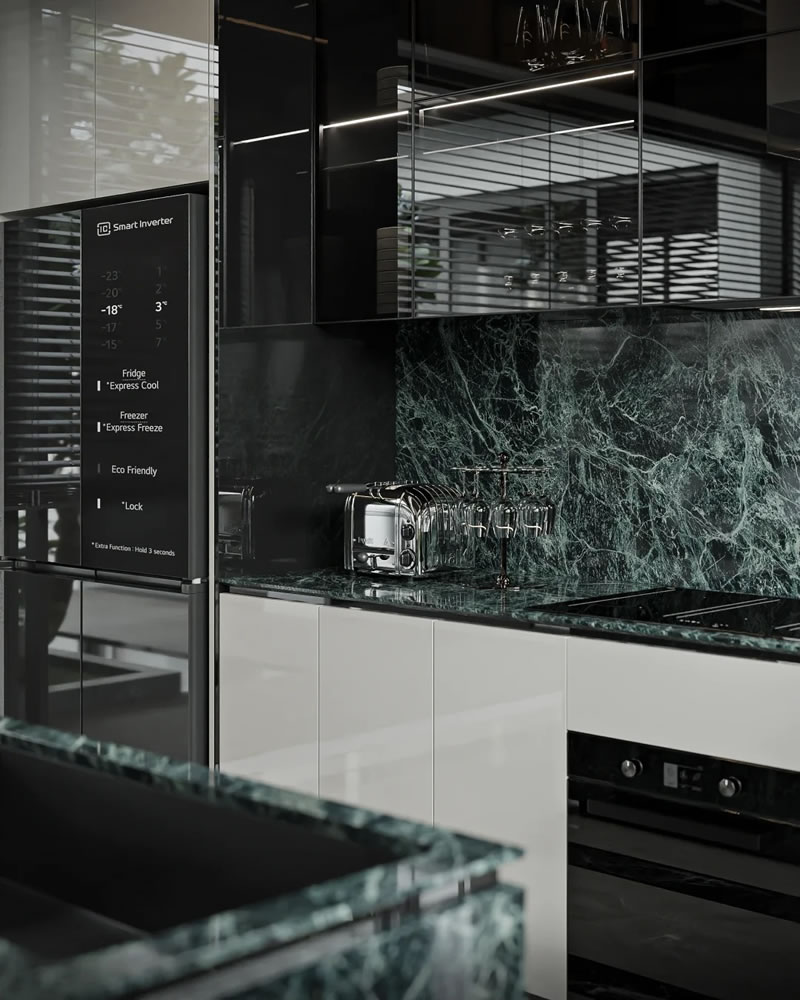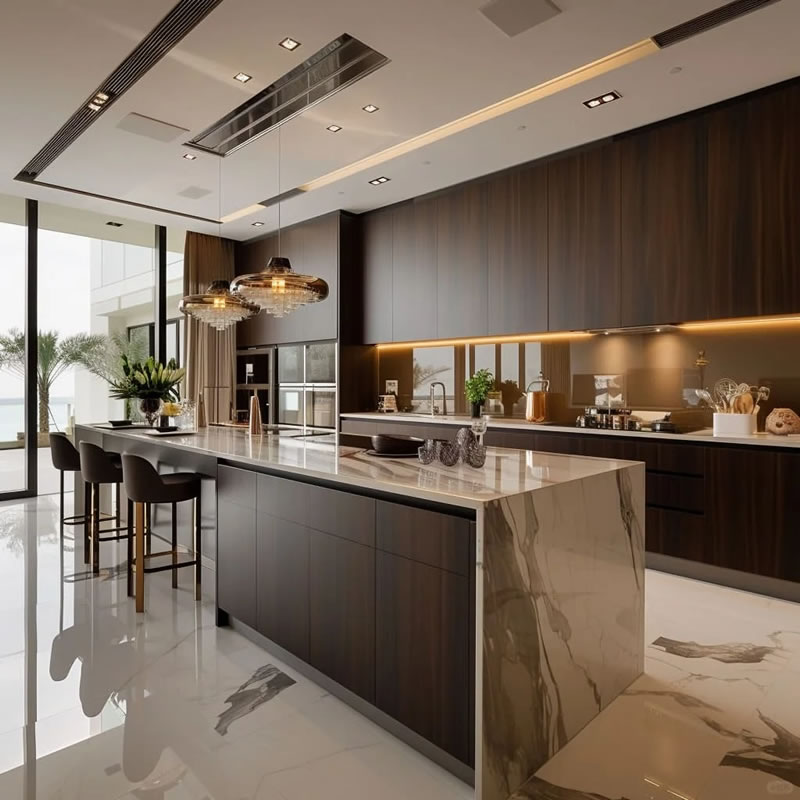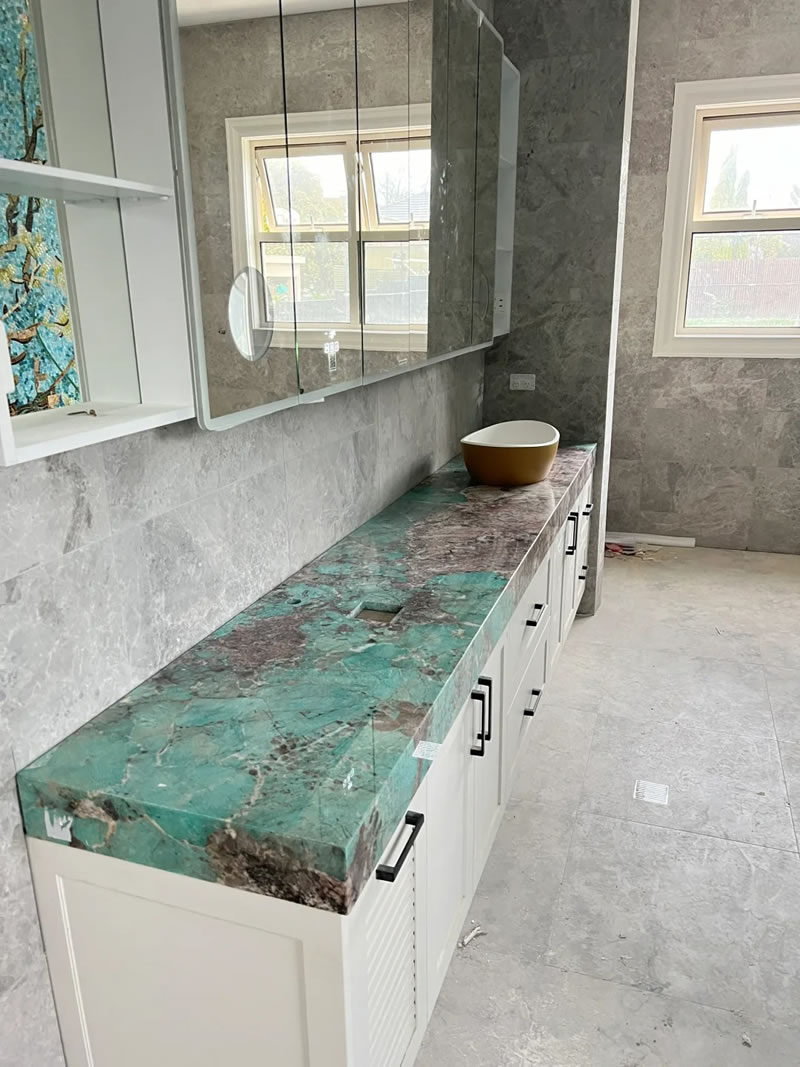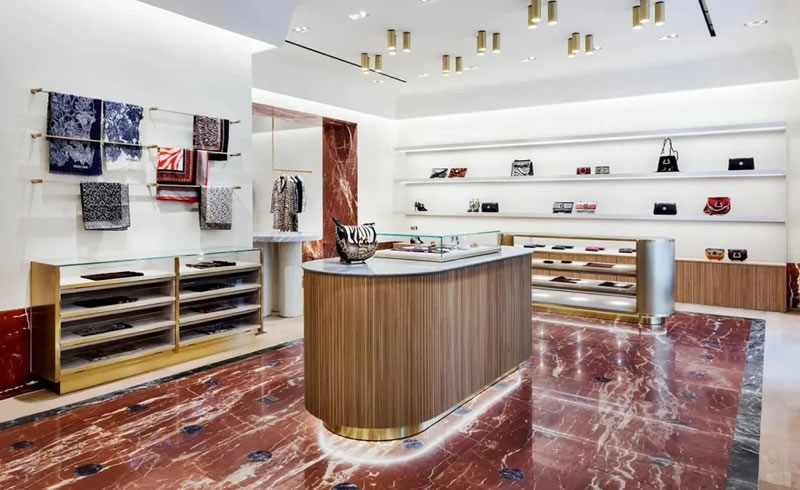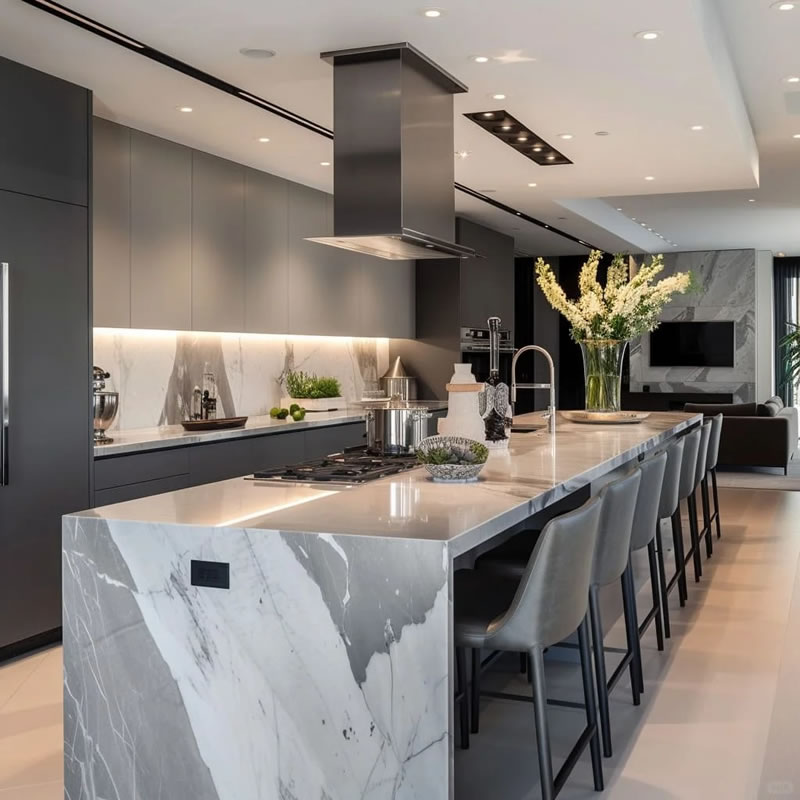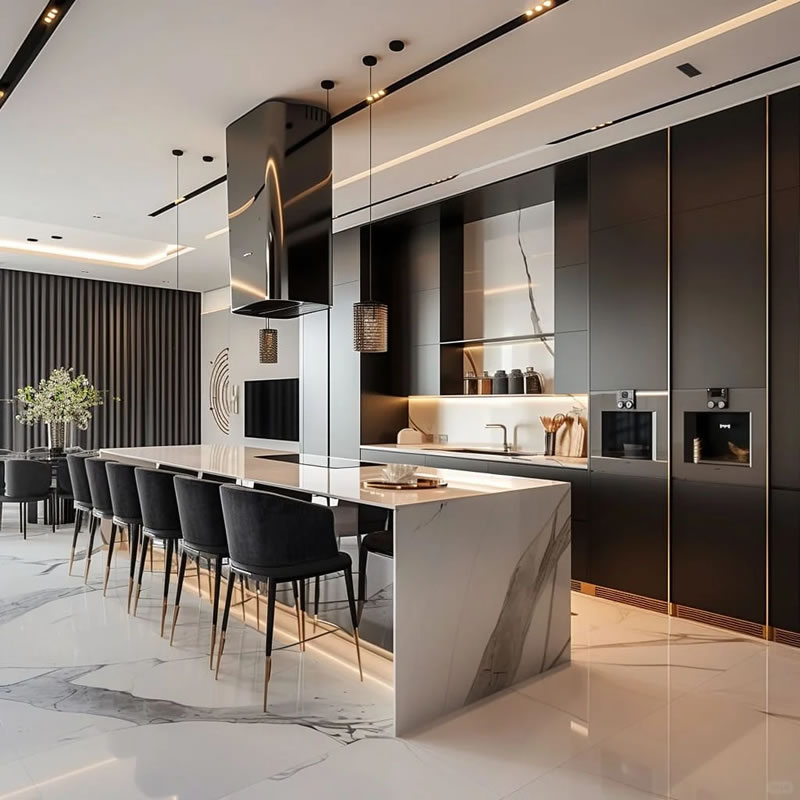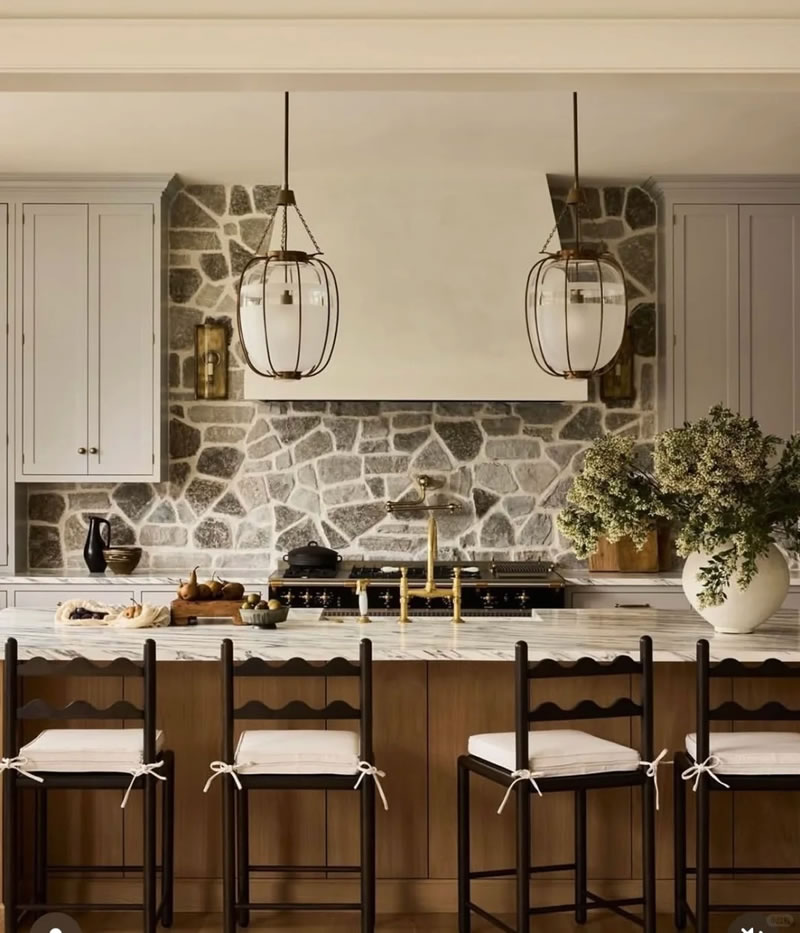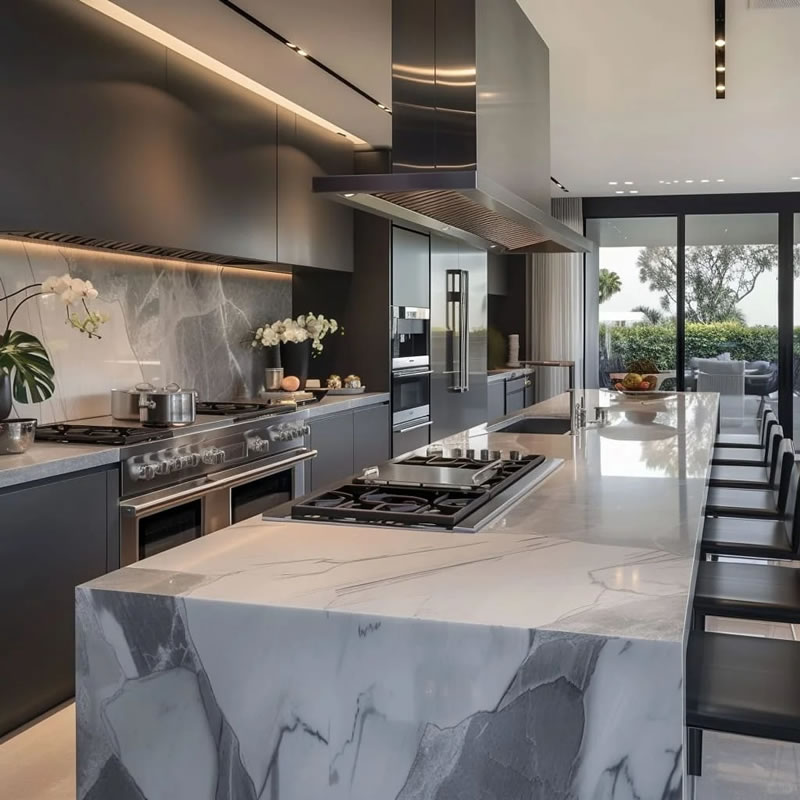When it comes to selecting marble for kitchens, several factors like durability, aesthetic appeal, maintenance requirements, and cost should be taken into account. Here’s an introduction to some of the best marble options for kitchens, along with their key characteristics:
1. Carrara Marble
Origin: Quarried in the Carrara region of Italy.
Appearance: Features a white or light gray base with soft, feathery gray veining, giving it a classic and elegant look.
Durability: Moderately durable but prone to etching and staining due to its calcium carbonate composition (reacting with acidic substances like citrus or vinegar).
Maintenance: Requires regular sealing (every 6–12 months) to protect against stains. Wipe up spills immediately to prevent damage.
Suitability: Ideal for kitchens with a minimalist or traditional design. Best used for low-traffic areas like backsplashes or accent countertops, rather than heavy-use islands.
Cost: Relatively affordable compared to other marbles, making it a popular choice for budget-conscious projects.
Appearance: Features a white or light gray base with soft, feathery gray veining, giving it a classic and elegant look.
Durability: Moderately durable but prone to etching and staining due to its calcium carbonate composition (reacting with acidic substances like citrus or vinegar).
Maintenance: Requires regular sealing (every 6–12 months) to protect against stains. Wipe up spills immediately to prevent damage.
Suitability: Ideal for kitchens with a minimalist or traditional design. Best used for low-traffic areas like backsplashes or accent countertops, rather than heavy-use islands.
Cost: Relatively affordable compared to other marbles, making it a popular choice for budget-conscious projects.
2. Calacatta Marble
Origin: Also from Italy, often quarried near Carrara.
Appearance: Characterized by bold, dramatic veining (golden, gray, or brown) on a bright white background, creating a luxurious and striking aesthetic.
Durability: Similar to Carrara in hardness but slightly more resistant to etching due to its denser structure in some varieties.
Maintenance: Still requires sealing, but its bold patterns can camouflage minor stains or etching better than lighter marbles.
Suitability: Perfect for high-end kitchens where a statement piece is desired. Works well for countertops, waterfall islands, or decorative elements.
Cost: Higher than Carrara due to its rarity and vivid veining, making it a premium choice.
Appearance: Characterized by bold, dramatic veining (golden, gray, or brown) on a bright white background, creating a luxurious and striking aesthetic.
Durability: Similar to Carrara in hardness but slightly more resistant to etching due to its denser structure in some varieties.
Maintenance: Still requires sealing, but its bold patterns can camouflage minor stains or etching better than lighter marbles.
Suitability: Perfect for high-end kitchens where a statement piece is desired. Works well for countertops, waterfall islands, or decorative elements.
Cost: Higher than Carrara due to its rarity and vivid veining, making it a premium choice.
3. Statuario Marble
Origin: Mined in Italy, particularly in the Apuan Alps.
Appearance: Features thick, bold gray veining on a pure white background, creating a striking, timeless look. The veining is often more defined and less uniform than Calacatta.
Durability: Denser and harder than Carrara, offering better resistance to daily wear and tear.
Maintenance: Sealing is still essential, but its robust nature makes it suitable for moderate to high-traffic kitchens.
Suitability: Adds a touch of luxury to modern or traditional kitchens. Popular for large countertops, dining tables, or wall cladding.
Cost: Falls into the high-end category due to its rarity and distinctive appearance.
Appearance: Features thick, bold gray veining on a pure white background, creating a striking, timeless look. The veining is often more defined and less uniform than Calacatta.
Durability: Denser and harder than Carrara, offering better resistance to daily wear and tear.
Maintenance: Sealing is still essential, but its robust nature makes it suitable for moderate to high-traffic kitchens.
Suitability: Adds a touch of luxury to modern or traditional kitchens. Popular for large countertops, dining tables, or wall cladding.
Cost: Falls into the high-end category due to its rarity and distinctive appearance.
4. Arabescato Marble
Origin: Quarried in Italy and other regions like Spain.
Appearance: Combines a white or off-white base with intricate, web-like gray or taupe veining, resembling natural stone art.
Durability: Moderate hardness; similar to Carrara in terms of susceptibility to etching but with a more forgiving pattern.
Maintenance: Regular sealing is recommended, and gentle cleaning with pH-neutral detergents is essential.
Suitability: Adds texture and visual interest to kitchens, working well in both contemporary and rustic designs. Suitable for countertops, backsplashes, or flooring.
Cost: Mid-to-high range, depending on the veining complexity and origin.
Appearance: Combines a white or off-white base with intricate, web-like gray or taupe veining, resembling natural stone art.
Durability: Moderate hardness; similar to Carrara in terms of susceptibility to etching but with a more forgiving pattern.
Maintenance: Regular sealing is recommended, and gentle cleaning with pH-neutral detergents is essential.
Suitability: Adds texture and visual interest to kitchens, working well in both contemporary and rustic designs. Suitable for countertops, backsplashes, or flooring.
Cost: Mid-to-high range, depending on the veining complexity and origin.
5. Emperador Marble
Origin: Mined in Spain and other countries like Turkey.
Appearance: Features warm tones of brown, beige, or gold with subtle veining, creating a rich, earthy aesthetic.
Durability: Slightly more resistant to stains than white marbles due to its denser composition and darker color.
Maintenance: Sealing is still necessary, but its darker hue hides minor imperfections better.
Suitability: Ideal for kitchens with warm color schemes or a traditional/transitional style. Works well for countertops, floors, or fireplace surrounds.
Cost: Moderate pricing, making it a versatile option for various budgets.
Appearance: Features warm tones of brown, beige, or gold with subtle veining, creating a rich, earthy aesthetic.
Durability: Slightly more resistant to stains than white marbles due to its denser composition and darker color.
Maintenance: Sealing is still necessary, but its darker hue hides minor imperfections better.
Suitability: Ideal for kitchens with warm color schemes or a traditional/transitional style. Works well for countertops, floors, or fireplace surrounds.
Cost: Moderate pricing, making it a versatile option for various budgets.
6. Thassos Marble
Origin: Quarried on the Greek island of Thassos.
Appearance: Pure white with minimal to no veining, offering a clean, minimalist look.
Durability: One of the hardest marbles, making it more resistant to scratches and etching compared to other varieties.
Maintenance: Requires sealing, but its simplicity highlights spills, so prompt cleaning is crucial.
Suitability: Perfect for modern or monochromatic kitchens where a sleek, bright look is desired. Great for countertops and backsplashes.
Cost: Premium pricing due to its rarity and purity.
Appearance: Pure white with minimal to no veining, offering a clean, minimalist look.
Durability: One of the hardest marbles, making it more resistant to scratches and etching compared to other varieties.
Maintenance: Requires sealing, but its simplicity highlights spills, so prompt cleaning is crucial.
Suitability: Perfect for modern or monochromatic kitchens where a sleek, bright look is desired. Great for countertops and backsplashes.
Cost: Premium pricing due to its rarity and purity.
Key Considerations for Kitchen Marble
- Sealing: Always seal marble countertops upon installation and reapply every 1–2 years (or as recommended by the fabricator) to minimize staining.
- Usage: Avoid placing hot pots directly on marble (use trivets) and wipe up acidic spills immediately.
- Aesthetic Match: Choose a marble that complements your kitchen’s color palette and style (e.g., white marbles for modern spaces, warm tones for traditional).
- Budget: Marble ranges from $50 to $200+ per square foot, depending on the type, origin, and finish (polished, honed, or leathered).
Conclusion
Marble adds timeless elegance to kitchens, but its suitability depends on your lifestyle and maintenance willingness. For high-traffic areas, opt for harder varieties like Thassos or well-sealed Statuario. For a luxurious yet practical touch, Calacatta or Emperador offer beauty and some stain resistance. Always consult with a professional fabricator to ensure proper installation and care for your chosen marble.
